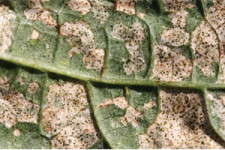Joining The Battle Against Thrips

Raymond Cloyd is only half joking when he says the battle against western flower thrips is over, and that the thrips have won.
“It’s a very precarious situation,” says Cloyd, an extension specialist in ornamental entomology at Kansas State University. “Resistance is out there.”
The specter of western flower thrips has haunted the worldwide floriculture industry for decades. Thrips damage plants directly by feeding and indirectly by vectoring tospoviruses such as tomato-spotted wilt virus (TSWV) and impatiens necrotic spot virus (INSV). Thrips breed quickly inside greenhouses and are difficult to detect due to their tendency to hide inside closed buds or in the soil. As a result, they are often transported on plant material. This becomes especially serious if the hitchhikers are resistant to insecticides.
“Thrips are a huge, huge issue for flowering ornamentals–anything where the feature of the plant is the flower,” says Joe Chamberlin, regional field development manager for Valent Professional Products. “Many floriculture crops can be severely damaged by western flower thrips, whose adverse effect on flowers can make plants unmarketable.”
While thrips are an issue for growers of all sizes, they are particularly troublesome for large growers with year-round flower production because of the thrips’ tendency to move from one crop to another, says Scott Ludwig, an entomologist and integrated pest management specialist with the Texas AgriLife Extension Service, a member of Texas A&M System.
Thrips and the diseases they help spread have caused untold millions in losses to ornamental, fruit and vegetable crops worldwide over the past 30 years.
“Around the United States, thrips were getting more and more difficult to control because they’re developing resistance to available insecticides,” Ludwig says. “We need more treatment options on the market. Thankfully, we may get the help we need.”
Divide & Conquer
Until recently, the most effective weapon against western flower thrips was Conserve SC specialty insecticide. However, chronic overuse of Conserve and a lack of reliable rotational partners have resulted in resistance buildup, thus compromising the efficacy of what many considered the only surefire thrips control product.
The introduction of Pylon–and, more recently, Overture Insecticide–has provided growers with much-needed new options in the increasingly complicated fight against thrips. As rotational partners, products such as Overture and Pylon have helped extend the life of Conserve.
“Overture and Pylon are very good thrips products,” Chamberlin says. “We need to conserve Conserve, and these two products help do that.”
Ludwig has become all too well acquainted with the commercial devastation wrought by thrips. Last year, his team documented one East Texas grower with major resistance issues and another who was on the verge.
“Neither grower has had problems managing thrips so far this year,” Ludwig says. “With Overture and Pylon being on the market, they have new rotational partners for Conserve.”
While Ludwig describes Overture as a somewhat slower-working product than Conserve, which could once be counted on to knock down thrips within 24 hours, he has seen strong, consistent results from Overture within 14 days.
Tim Pfaffel, pest management supervisor at Iwasaki Bros., Inc. Wholesale Growers in Hillsboro, Ore., says his operation had major problems with thrips in 2008. After developing a joint insecticide-beneficial program that incorporated Overture, Conserve, the cucumeris mite and the Orius bug, Pfaffel says his thrips situation is not even a quarter as bad as it was last year.
The message of rotation, Chamberlin says, is important for thrips because it is one of the best ways to fight resistance. Overture, which has the added benefit of controlling caterpillars, is most effective against thrips when applied early in the rotation.
Weeding Out Trouble Spots
Whatever products or beneficial insects growers use in their attempts to keep thrips under control, there are a number of remedial measures that can be taken to limit infestation. Communication and sanitation, Ludwig says, should be an important part of any growing operation.
“Large operations often have different growers managing different areas, and they often don’t talk among themselves,” Ludwig says. “You have to know what your whole operation is doing on the pest management side.”
It is also important to keep both the inside and perimeter areas around greenhouses clear of weeds. Pet plants–in which thrips often thrive and through which dangerous tospoviruses are easily spread–should be removed.
“Sanitation is critical,” Ludwig says. “If you don’t need them, get rid of them.”
Echoing Ludwig, Kansas State’s Cloyd urges growers to take a holistic approach toward controlling thrips. That means careful, coordinated rounds of screening, monitoring and scouting.
Whenever young plants or cuttings enter the greenhouse, they should be checked immediately for thrips nymphs and adults, according to a report by the University of Connecticut’s Integrated Pest Management program. Also, any infected plants should be kept separate from non-infected ones to discourage the spread of thrips.
“Do everything you can to limit buildup,” Cloyd says. “It takes everything. Growers have to understand that. It’s just critical.”









